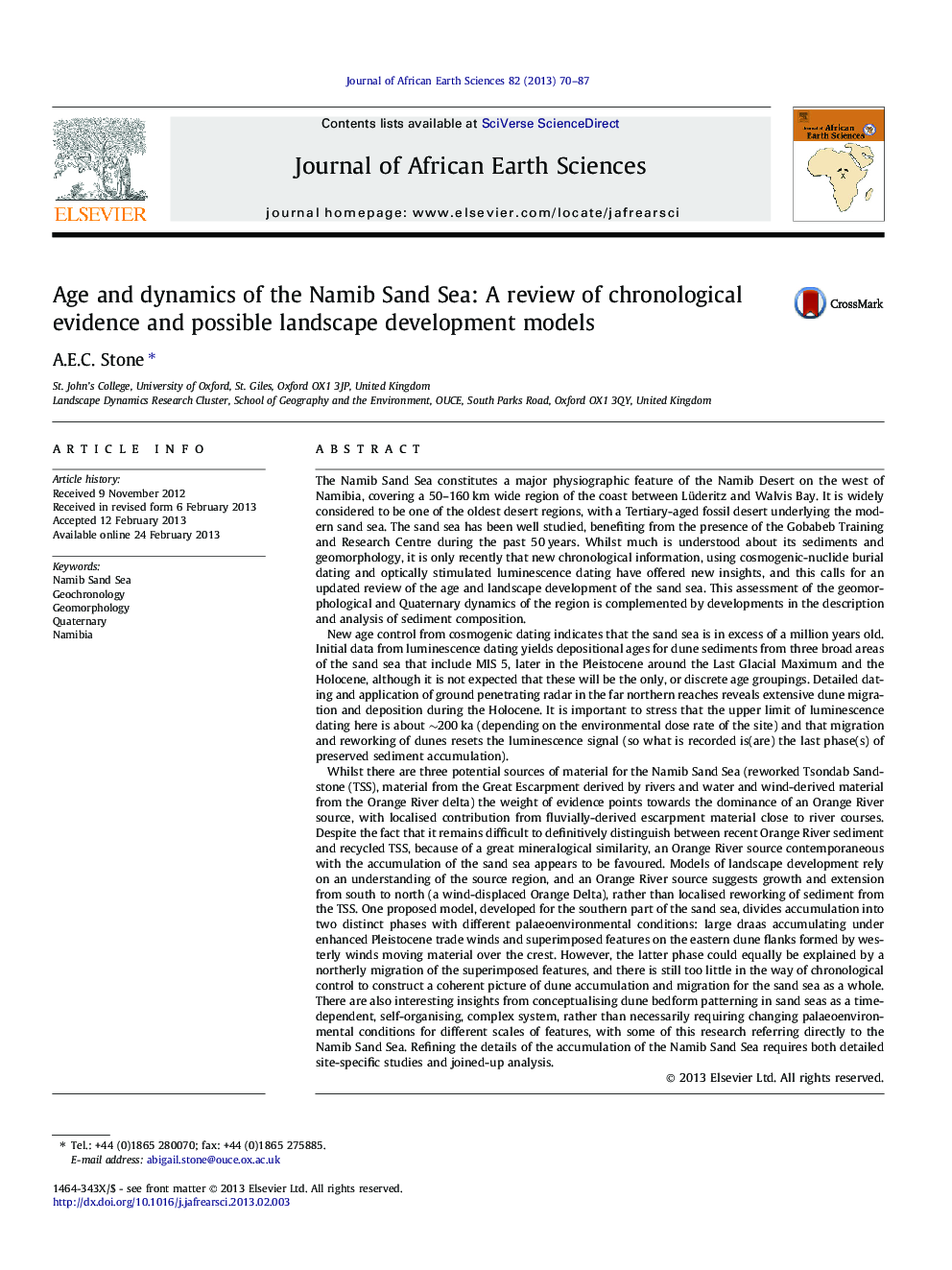| کد مقاله | کد نشریه | سال انتشار | مقاله انگلیسی | نسخه تمام متن |
|---|---|---|---|---|
| 4728934 | 1640224 | 2013 | 18 صفحه PDF | دانلود رایگان |
The Namib Sand Sea constitutes a major physiographic feature of the Namib Desert on the west of Namibia, covering a 50–160 km wide region of the coast between Lüderitz and Walvis Bay. It is widely considered to be one of the oldest desert regions, with a Tertiary-aged fossil desert underlying the modern sand sea. The sand sea has been well studied, benefiting from the presence of the Gobabeb Training and Research Centre during the past 50 years. Whilst much is understood about its sediments and geomorphology, it is only recently that new chronological information, using cosmogenic-nuclide burial dating and optically stimulated luminescence dating have offered new insights, and this calls for an updated review of the age and landscape development of the sand sea. This assessment of the geomorphological and Quaternary dynamics of the region is complemented by developments in the description and analysis of sediment composition.New age control from cosmogenic dating indicates that the sand sea is in excess of a million years old. Initial data from luminescence dating yields depositional ages for dune sediments from three broad areas of the sand sea that include MIS 5, later in the Pleistocene around the Last Glacial Maximum and the Holocene, although it is not expected that these will be the only, or discrete age groupings. Detailed dating and application of ground penetrating radar in the far northern reaches reveals extensive dune migration and deposition during the Holocene. It is important to stress that the upper limit of luminescence dating here is about ∼200 ka (depending on the environmental dose rate of the site) and that migration and reworking of dunes resets the luminescence signal (so what is recorded is(are) the last phase(s) of preserved sediment accumulation).Whilst there are three potential sources of material for the Namib Sand Sea (reworked Tsondab Sandstone (TSS), material from the Great Escarpment derived by rivers and water and wind-derived material from the Orange River delta) the weight of evidence points towards the dominance of an Orange River source, with localised contribution from fluvially-derived escarpment material close to river courses. Despite the fact that it remains difficult to definitively distinguish between recent Orange River sediment and recycled TSS, because of a great mineralogical similarity, an Orange River source contemporaneous with the accumulation of the sand sea appears to be favoured. Models of landscape development rely on an understanding of the source region, and an Orange River source suggests growth and extension from south to north (a wind-displaced Orange Delta), rather than localised reworking of sediment from the TSS. One proposed model, developed for the southern part of the sand sea, divides accumulation into two distinct phases with different palaeoenvironmental conditions: large draas accumulating under enhanced Pleistocene trade winds and superimposed features on the eastern dune flanks formed by westerly winds moving material over the crest. However, the latter phase could equally be explained by a northerly migration of the superimposed features, and there is still too little in the way of chronological control to construct a coherent picture of dune accumulation and migration for the sand sea as a whole. There are also interesting insights from conceptualising dune bedform patterning in sand seas as a time-dependent, self-organising, complex system, rather than necessarily requiring changing palaeoenvironmental conditions for different scales of features, with some of this research referring directly to the Namib Sand Sea. Refining the details of the accumulation of the Namib Sand Sea requires both detailed site-specific studies and joined-up analysis.
► Review of age of, and models of, landscape development in the Namib Sand Sea.
► Approaches to assessing the age of dune forms are reviewed.
► Ideas about sand seas development are tightly connected to sediment sources.
► Sand sea is >1 million years old, with later Pleistocene and Holocene deposition.
► Landscape development may include northerly migration and bedform self-organisation.
Journal: Journal of African Earth Sciences - Volume 82, June 2013, Pages 70–87
